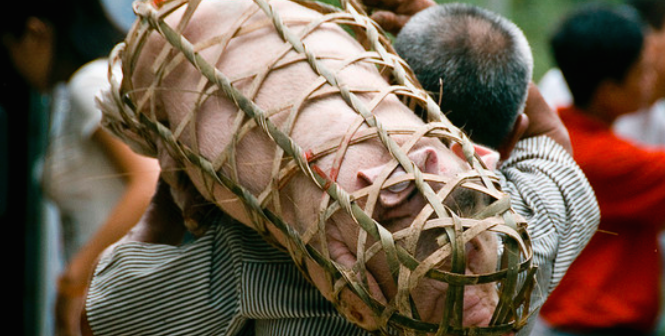Counter-Attacking Human and Pig Disease in Asia

Demand for pig meat during festival periods in Southeast Asia jumps up to 40 percent, yet growing human health concerns have prompted investment in training farmers in correct pig management.
Lao PDR’s northern-most province lies among cloud-covered peaks between China to the west and Vietnam to the east. The mountains here, along the eastern edge of Phongsaly province, are cut by a narrow winding pass – a trade route with Vietnam becoming more popular amid rising demand for pig meat.
Fuelled by affluent regional populations and population growth, demand for pig meat during some festival periods in Vietnam and Laos can jump 20-40% according to locals, sparking a steady trickle of trade between countries.
Yet a human-health concern has prompted investigations into high incidences of the tapeworm parasite Taenia solium. The larval stage of Taenia solium – cysticercosis – causes cysts in humans and pigs. In the human brain, cysts – neurocysticercosis – can lead to seizures or even death.
The adult tapeworm is spread by eating raw or undercooked pork contaminated with larval cysts, and the cycle of infection is closed by roaming pigs which consume infected human faeces.
In some villages in northern Laos, incidence rates of human taeniasis are as high as 25%, up from 4% – still considered endemic – in areas. A One Health joint approach has been launched into pig and human health by the International Center for Tropical Agriculture (CIAT), ACIAR, and the International Livestock Research Institute (ILRI) and local partners including the National Agriculture and Forestry Research Institute (NAFRI).
Anna Okello, ACIAR Country Project Coordinator for human and animal health, said: “We’re optimistic that current medical and educational efforts can be successful in controlling the disease. However, more work is required to raise awareness of this disease and roll out control interventions where they are most required.”
At the same time, better pig management led by CIAT is expected to improve pig production – with positive impacts on human health, smallholder profits and more efficient natural resource use, for a more robust farming system.
Four-pronged approach to healthier pigs
In the last of the fading light before thick mist settles, Ammaly Phengvilaysouk is busy talking with a group of farmers in a small hamlet of Phongsaly, noting down how many sacks of pig feed each has received. He’s a familiar face here.
Head of the Pig Research Station at the Lao NAFRI’s Livestock Research Center, he explains: “More than 85% of farmers in Laos keep pigs. When farmers need money for school fees, health problems or rice shortages they sell the pigs, and they are eaten during festivals.”
Since 2011, Phengvilaysouk and his team have implemented a four-pronged approach to improving pig production, training around 40 volunteer champion farmers in four basic steps: penning, fattening, vaccinations and forage feeding.
Penning pigs can contain disease spread, and feeding them high-quality forages like Stylosanthes guianensis or Aeschynomene histrix increases their survival rate. Pigs fed low-quality wild fodder don’t grow fast enough or fetch good prices.
Tassilo Tiemann, CIAT’s forage and livestock systems specialist leading the research, explained: “Investing in feed concentrate is more expensive – but ten pigs can bring in a US$200-300 profit: a considerable amount for smallholders.”
“Initially, farmers didn’t understand well-functioning pig production systems,” he added. “Farmers couldn’t justify the work involved in growing forages. So we provided animals and feed under contractual agreement, and farmers pay back the initial costs.”
Pigs to market…
Not long ago, Mrs. Seng, a smallholder pig farmer, kept a few pigs in case she needed emergency cash. But they were left to roam around the village to find feed, and most died of disease.
“I improved my pig pens using my own wood and labor,” she said. “I learned how to set up a water system; install a separate feeding trough to avoid contamination with waste, and percentages for mixing pig feed at different stages of pig growth”.
She has bought and fattened 14 pigs in total, doubling her US$1,100 annual income from coffee, rice, bamboo shoots and cardamom to around US$2,300, feeding her pigs concentrate feed mixed with high-quality forages.
Although she reinvests some 80% of her profits in feed, she has more money for household items. “Now it takes five months to fatten pigs instead of three years,” she said. She has also learned de-worming, vaccination, piglet care and sale strategies.
Rocky road ahead
Significant challenges remain in market and drug supply chains in Laos and farmers need better information about improved pig management on a larger scale to meet growing demand, say researchers.
Jonathan Newby, CIAT’s regional rural resource economist, notes: “Farmers have to decide how much time and resources to invest in pigs relative to other opportunities. At the same time, traders will only come looking for pigs if a reliable supply is available.”
But already around 14 pigs are traded daily with Vietnam – up from two in the local market through new links with the Vietnamese Department for Agriculture and Rural Technology. Some local trade restrictions in Laos have also been removed, with improved profits expected to improve long-term pig management.
This article was written by Georgina Smith and was first published on the CIAT Blog and on the Australian Centre for International Agricultural Research (ACIAR) blog on 5 May 2015. It is republished with permission.





